141. Crowned Eagle Stephanoaetus coronatus (Kroonarend)
Order: Accipitriformes. Family: Accipitridae
Description
Length: 80-90 cm. Wingspan: up to 180 cm. Male weight: 2.7-4.1 kg. Female weight: 3.1-4.7 kg. One of the largest and most powerful eagles in Africa.
The head, back and wings are black or dark brown, the breast is cream or reddish, with distinctive black mottling or barring, and there is a long crest on the head which can be raised and which gives the species its common name. The tail is long and boldly marked with three black bands, and in flight the broad, rounded wings show a reddish underside, with white flight feathers that are clearly marked with three black bands in adult males and two in adult females. The feet are large, yellow and the legs bear barred, feathery “boots” right down to the ankles. The beak is also large and strong, with a conspicuous orange gape-flange (yellow in juveniles), but a dark grey cere. The eyes are a piercing pale yellow.
The female is larger than the male, and has heavier marking on the breast and a smaller crest.
The juvenile is distinct, being pale grey-brown above, with white scale-like edges to the feathers, a grey-brown tail, which has four dark bars in males and three in females, and a white head and underparts. Long, broadly barred tail and white (not grey spotted) neck separates from juvenile Martial Eagle. During its first few years, the juvenile gradually becomes darker and gains its black markings, but does not achieve full adult plumage until its fourth or even fifth year. Fledglings have grey eyes, which turn brown and then yellow as the bird matures.
Immatures resemble immature Martial Eagles but can be distinguished from that species by their heavily barred underwings and blotchy buff underwing coverts and underbody.
Distribution
Occurs from Guinea to South Africa, with an isolated population in Ethiopia. In southern Africa, it is generally uncommon in Zimbabwe, central Mozambique and eastern and southern South Africa.
Habitat
It generally prefers forest habitats, such as gallery forest, dense woodland, forest gorges in savanna or grassland and alien tree plantations.
Diet
It mainly eats mammals (especially hyraxes and antelope), doing most of its hunting from a perch just below the canopy, swooping down on its prey from above. Pairs sometimes hunt cooperatively to catch monkeys, using a clever technique whereby one bird flies above the canopy overhead of a monkey troop, eliciting alarm calls from them which exposes their position. The eagle's mate then follows a short while later, killing from behind any monkey unfortunate enough to be caught out in the open. It usually strikes the skull or diaphragm of prey with its talons in a downward motion, a movement powerful enough to kill instantly.
Breeding
Crowned Eagle pairs breed once every two years. A single breeding cycle is approximately 500 days.
The nest is built mainly by the female in about 5-6 weeks, consisting of a large platform built of branches up to about 1.5 m long and lined with the leaves of Willow beachwood (Faurea saligna) and Eucalytus. It is typically placed in the highest forked branch of the tallest available smooth-barked tree, about 15-55 m above ground. It is often positioned at the base of a ravine or at the edge of a plantation, using the same site over multiple breeding seasons and only rebuilding a new nest if the previous one is lost. Egg-laying season is from July-May, peaking from August-October. It lays 1-2, usually 2 eggs, which are incubated mainly the female for about 49-51 days. Occasionally when the male is incubating the female gives him prey as a gift, a unique behaviour among African eagles. The chicks are brooded by the female for the first 21 days or so of their lives, while the male hands her a prey item to feed to them every circa one and a half days, never feeding them himself. When the young become about 60 days old the female starts to hunt for them as well, soon surpassing the male in deliveries of food to the nest. Even though it usually lays 2 eggs, only one chick usually lives to become a juvenile, meaning that it is highly likely that one chick kills and eats the other at some point during the nestling period. At about 110-115 days old the lone nestling typically clambers on to the branches surrounding the nest and takes its first flight, remaining reliant on its parents for food for 9-11 months longer before becoming fully independent.
Call
Pairs are fairly vocal in their territory. The call is a cheeep chereep chereep. Listen to Bird Call.
Status
Locally common resident. It has been uplisted to Near Threatened on the IUCN List.
Africa Wild Bird Book
African Crowned Eagle Photos
141. African Crowned Eagle Stephanoaetus coronatus
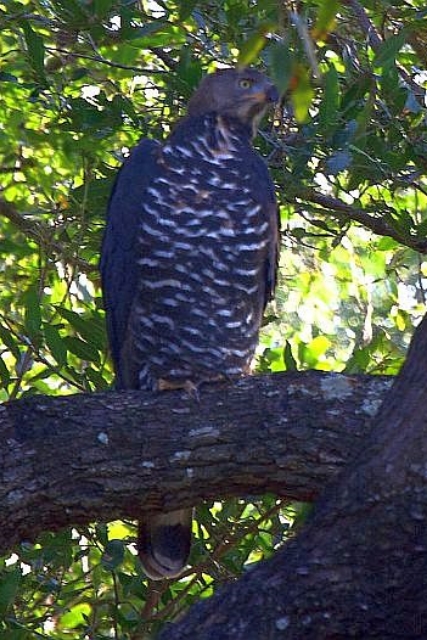 © Sharifa
© Sharifa
Kruger National Park
 © Richprins
© Richprins
Kruger National Park, Pafuri
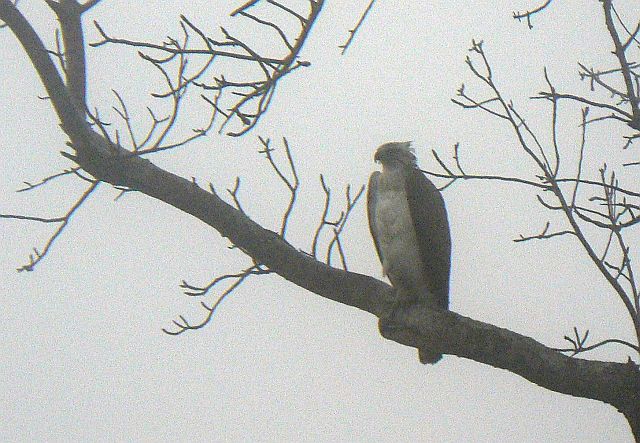 © Toko
© Toko
Juvenile. Tembe Elephant Park
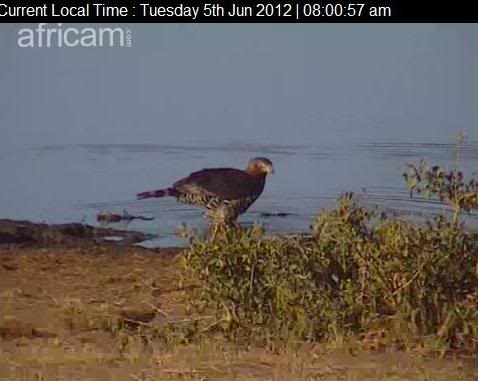
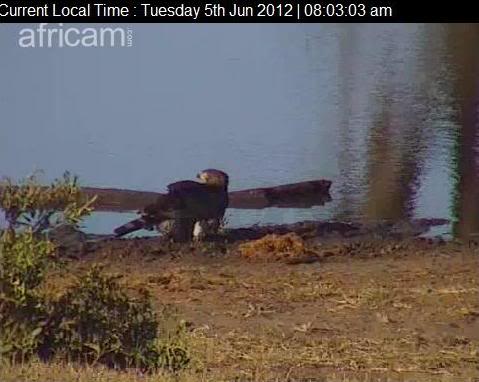
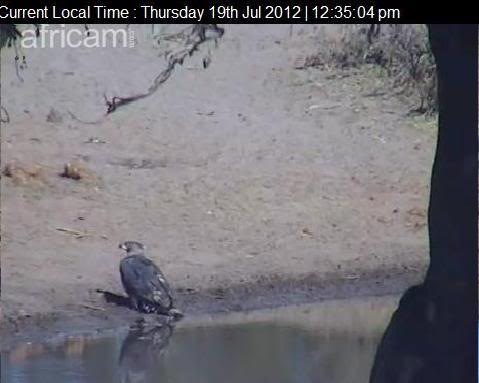
Tembe Elephant Park
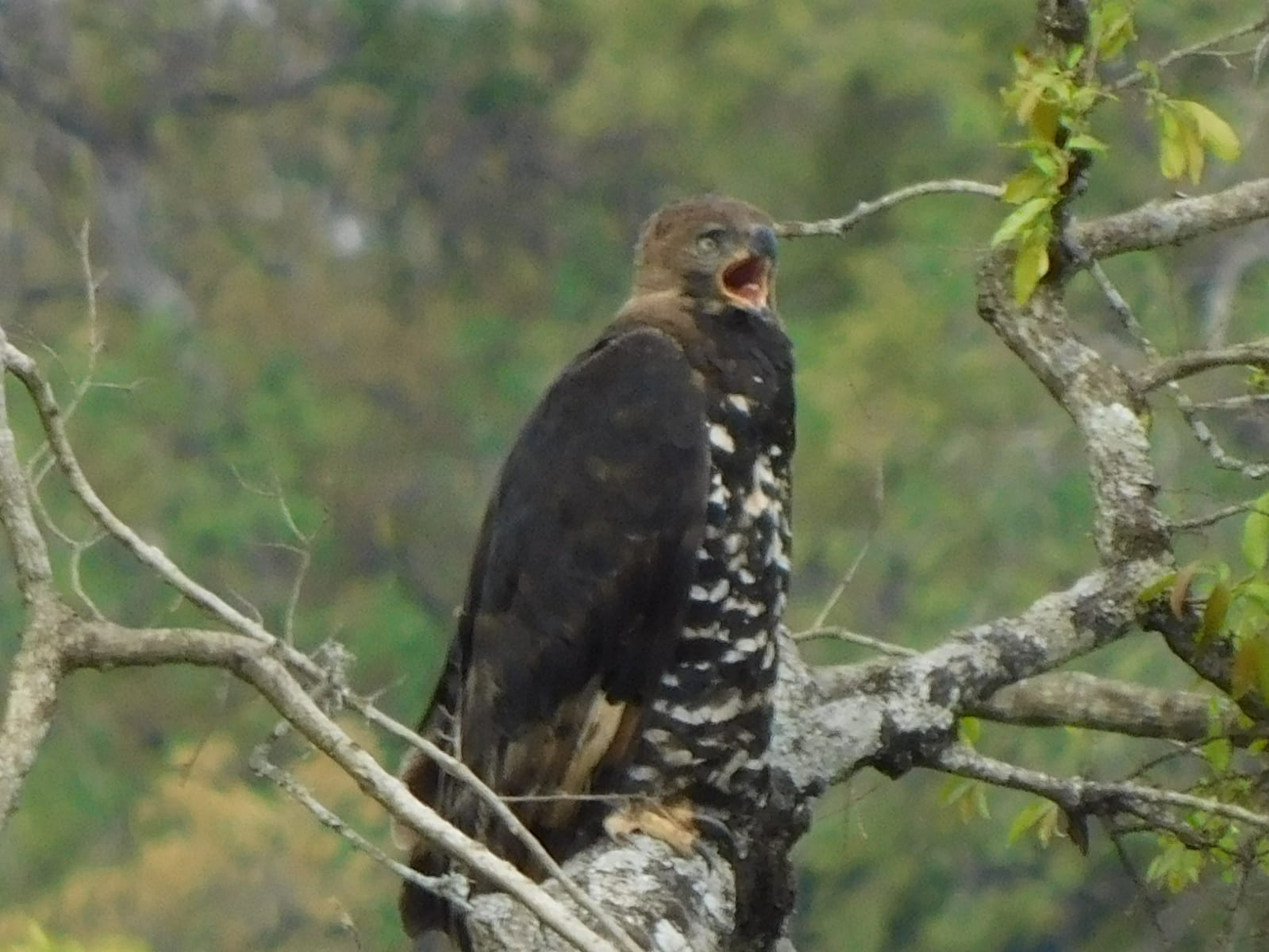
Kruger Sightings
@LatestKruger
8:48am
1 African Crowned Eagle stationary
S1, 2km N side just after the bridge near Phabeni
4/5
Tinged by The Lehmanns
11:22 AM · Sep 29, 2022
Links:
Species text in The Atlas of Southern African Birds: http://sabap2.adu.org.za/docs/sabap1/141.pdf
Sabap2: http://sabap2.adu.org.za/spp_summary.ph ... §ion=3
Sasol Birds of Prey of Africa
Interview with Garth Batchelor about the African Crowned Eagle in South Africa
Global Raptor Information Network
Oiseaux net: http://www.oiseaux-birds.com/card-crown ... eagle.html
 © Sharifa
© SharifaKruger National Park
 © Richprins
© RichprinsKruger National Park, Pafuri
 © Toko
© TokoJuvenile. Tembe Elephant Park



Tembe Elephant Park

Kruger Sightings
@LatestKruger
8:48am
1 African Crowned Eagle stationary
S1, 2km N side just after the bridge near Phabeni
4/5
Tinged by The Lehmanns
11:22 AM · Sep 29, 2022
Links:
Species text in The Atlas of Southern African Birds: http://sabap2.adu.org.za/docs/sabap1/141.pdf
Sabap2: http://sabap2.adu.org.za/spp_summary.ph ... §ion=3
Sasol Birds of Prey of Africa
Interview with Garth Batchelor about the African Crowned Eagle in South Africa
Global Raptor Information Network
Oiseaux net: http://www.oiseaux-birds.com/card-crown ... eagle.html
- Bushveld Jock
- Posts: 2001
- Joined: Sat Jun 02, 2012 3:52 pm
- Contact:
Martial Eagle
140. Martial Eagle Polemaetus bellicosus (Breëkoparend)
Order: Accipitriformes. Family: Accipitridae
Description
Distinctive large, long-legged eagle, length 78-83 cm, weight 3-6 kg. It has the largest wingspan (2.6 m) of any African eagle. When perched it appears tall and thickset with a broad, flat head and short tail. It has a slight crest and feathered legs. The dark head, throat and upper breast, combined with the white, lightly spotted breast and belly and very dark underwings are diagnostic in this eagle. In flight, the underside of the body contrasts to both the head/throat and to underside of wings which also are dark brown. Eyes yellow, cere and feet grey.
Sexes alike but female is larger.
Juvenile has head and breast pale. It is pale fringed grey brown above, white unspotted below with all white underwing coverts and white leg feathering. It attains adult plumage over 4-5 years. The eyes are brown, cere and toes whitish or grey.
Similar species: Most similar to Black-chested Snake-eagle but differing in spotted underparts and fully feathered legs, in flight by dark underwings.
Confusion could occur between immature African Crowned Eagle and immature Martial Eagle, but perched Martial is broader- shouldered, showing primaries reaching tip of tail, while wings of Crowned only reach the rump and reveal a conspicuously barred tail. The Martial juvenile's white feathering on legs and flight feathers on the underwing with many thin dark bands separate this from juvenile African Crowned Eagle. Juvenile Martial Eagle is longer-winged and whiter, has unspotted flanks.
Distribution
Occupies much of sub-Saharan Africa, excluding the lowland of West Africa and the DRC. In southern Africa (excluding Lesotho), it is widespread but uncommon. It occurs right across southern Africa with concentrations in Kruger NP, and the Kgalagadi Transfrontier Park of South Africa, and the Chobe NP, Botswana.
Habitat
Flat, open woodland, such as savanna, forest edges and drainage woodland in shrubland. It may move into open farmland with stands of trees.
Diet
It eats a variety of animals, especially birds, mammals and reptiles; the relative proportion of these animals in it's diet varies greatly in different areas. It does most of its hunting aerially, soaring high in the air so that it can spot prey up to 6km away. Once it finds something, it descends in a long swoop, dropping to the ground with wings and tail spread and striking the prey. Small animals are usually killed by the impact, but larger prey may have to be strangled to finish them off.
Breeding
Monogamous, territorial solitary nester, with a pair bond that often lasts several breeding seasons. The female builds the nest over a period of 2-3 weeks. It consists of a large platform of sticks, with a central cup lined with leaves, which is usually about 1.5-2.0 m wide and 0.5 m deep, but if used many times it can be even deeper. It is typically placed in a large, forked branch below the canopy of a large tree, especially Knob thorn (Acacia nigrescens) and Camel thorn (Acacia erioloba); it also nests in high-tension pylon. Egg-laying season is from February-August, peaking from April-June. It almost invariably lays a single egg, which is mainly incubated by the female for about 48-53 days. The chick is brooded almost constantly by the female for 2-3 weeks, after which she starts to assist the male with hunting to provide for their young. The chick typically leaves the nest at about 90-109 days old, although male chicks may leave earlier. The fledgling continues to roost in the nest for another 3-8 months, still provided with food from the female; the fledgling leaves it's parents' territory at the start of the following breeding season.
Call
A loud call klee-klee-klee-kloeee-kloeee-kuleee on the wing during the breeding season and a weak whistling hlueee-oh high pitched, near the nest or when it is excited. Listen to Bird Call.
Status
Uncommon resident. Scarce outside large protected areas. Its conservation status was uplisted to Near Threatened in 2009 on the IUCN List. Vulnerable in South Africa and Endangered in Namibia, largely due to persecution on farmlands. This species is currently experiencing a major decline in numbers in areas where they come into contact with humans. Domestic animals constitute only a small proportion of their diet, whereas the presence of these eagles is a sure sign of a healthy environment. Reduction in natural prey may lead to an increase in predation on domestic animals which may in turn lead to increased persecution by farmers. In some areas birds may be taken for use in traditional medicine. The preservation of this species depends on education of farmers, and the direct protection of nesting sites.
Order: Accipitriformes. Family: Accipitridae
Description
Distinctive large, long-legged eagle, length 78-83 cm, weight 3-6 kg. It has the largest wingspan (2.6 m) of any African eagle. When perched it appears tall and thickset with a broad, flat head and short tail. It has a slight crest and feathered legs. The dark head, throat and upper breast, combined with the white, lightly spotted breast and belly and very dark underwings are diagnostic in this eagle. In flight, the underside of the body contrasts to both the head/throat and to underside of wings which also are dark brown. Eyes yellow, cere and feet grey.
Sexes alike but female is larger.
Juvenile has head and breast pale. It is pale fringed grey brown above, white unspotted below with all white underwing coverts and white leg feathering. It attains adult plumage over 4-5 years. The eyes are brown, cere and toes whitish or grey.
Similar species: Most similar to Black-chested Snake-eagle but differing in spotted underparts and fully feathered legs, in flight by dark underwings.
Confusion could occur between immature African Crowned Eagle and immature Martial Eagle, but perched Martial is broader- shouldered, showing primaries reaching tip of tail, while wings of Crowned only reach the rump and reveal a conspicuously barred tail. The Martial juvenile's white feathering on legs and flight feathers on the underwing with many thin dark bands separate this from juvenile African Crowned Eagle. Juvenile Martial Eagle is longer-winged and whiter, has unspotted flanks.
Distribution
Occupies much of sub-Saharan Africa, excluding the lowland of West Africa and the DRC. In southern Africa (excluding Lesotho), it is widespread but uncommon. It occurs right across southern Africa with concentrations in Kruger NP, and the Kgalagadi Transfrontier Park of South Africa, and the Chobe NP, Botswana.
Habitat
Flat, open woodland, such as savanna, forest edges and drainage woodland in shrubland. It may move into open farmland with stands of trees.
Diet
It eats a variety of animals, especially birds, mammals and reptiles; the relative proportion of these animals in it's diet varies greatly in different areas. It does most of its hunting aerially, soaring high in the air so that it can spot prey up to 6km away. Once it finds something, it descends in a long swoop, dropping to the ground with wings and tail spread and striking the prey. Small animals are usually killed by the impact, but larger prey may have to be strangled to finish them off.
Breeding
Monogamous, territorial solitary nester, with a pair bond that often lasts several breeding seasons. The female builds the nest over a period of 2-3 weeks. It consists of a large platform of sticks, with a central cup lined with leaves, which is usually about 1.5-2.0 m wide and 0.5 m deep, but if used many times it can be even deeper. It is typically placed in a large, forked branch below the canopy of a large tree, especially Knob thorn (Acacia nigrescens) and Camel thorn (Acacia erioloba); it also nests in high-tension pylon. Egg-laying season is from February-August, peaking from April-June. It almost invariably lays a single egg, which is mainly incubated by the female for about 48-53 days. The chick is brooded almost constantly by the female for 2-3 weeks, after which she starts to assist the male with hunting to provide for their young. The chick typically leaves the nest at about 90-109 days old, although male chicks may leave earlier. The fledgling continues to roost in the nest for another 3-8 months, still provided with food from the female; the fledgling leaves it's parents' territory at the start of the following breeding season.
Call
A loud call klee-klee-klee-kloeee-kloeee-kuleee on the wing during the breeding season and a weak whistling hlueee-oh high pitched, near the nest or when it is excited. Listen to Bird Call.
Status
Uncommon resident. Scarce outside large protected areas. Its conservation status was uplisted to Near Threatened in 2009 on the IUCN List. Vulnerable in South Africa and Endangered in Namibia, largely due to persecution on farmlands. This species is currently experiencing a major decline in numbers in areas where they come into contact with humans. Domestic animals constitute only a small proportion of their diet, whereas the presence of these eagles is a sure sign of a healthy environment. Reduction in natural prey may lead to an increase in predation on domestic animals which may in turn lead to increased persecution by farmers. In some areas birds may be taken for use in traditional medicine. The preservation of this species depends on education of farmers, and the direct protection of nesting sites.
Kgalagadi: Dec 2015
KNP Maroela, Shingwedzi & Pretoriuskop: March 2016
KNP Maroela, Shingwedzi & Pretoriuskop: March 2016
- Bushveld Jock
- Posts: 2001
- Joined: Sat Jun 02, 2012 3:52 pm
- Contact:
Martial Eagle Photos
140. Martial Eagle Polemaetus bellicosus
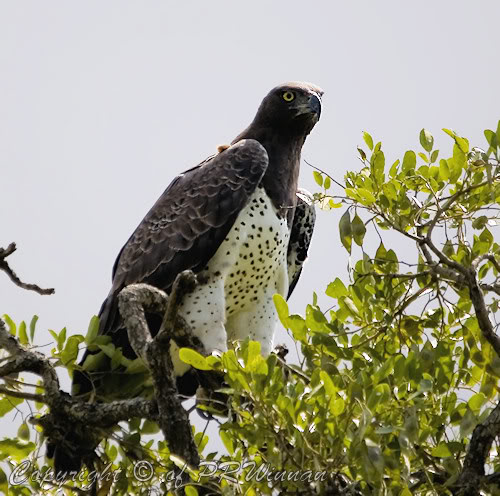
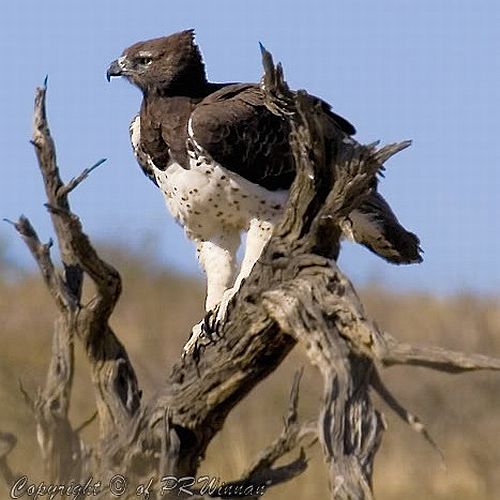
 © Bushcraft
© Bushcraft
Matrial Eagle with full crop feeding on a Water Monitor, Kruger National Park, S39
Most raptors, including eagles, have a crop which is an out pouching of the esophagus, where they can store food when the stomach is full, or hold back indigestible stuff, such as feathers, fur, scales. This is than mixed with mucus and regurgitated.
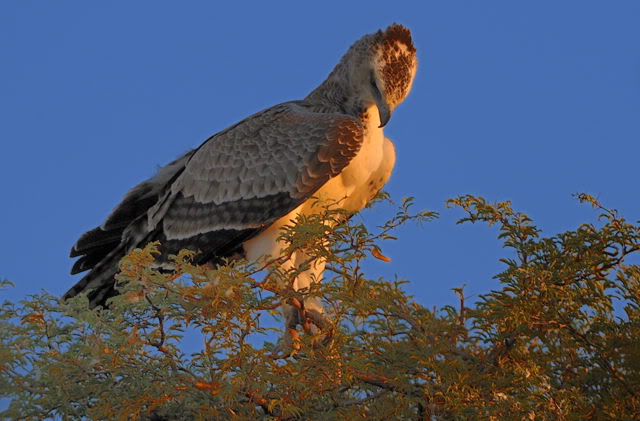 © Dewi
© Dewi
Juvenile, Kgalagadi Transfrontier Park
 © The Cow
© The Cow
Juvenile
 © ExFmem
© ExFmem
Juvenile
 © Sprocky
© Sprocky
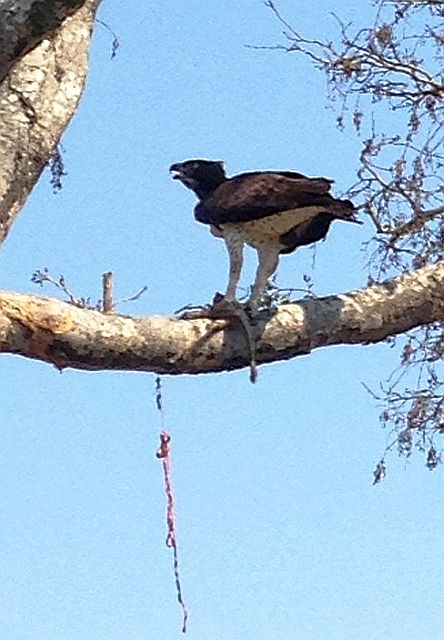 © Goldenboy
© Goldenboy
Martial Eagle eating a Vervet Monkey, Kruger National Park, Phabeni Road
 © Toko
© Toko
Nest in the Kgalagadi Transfrontier Park
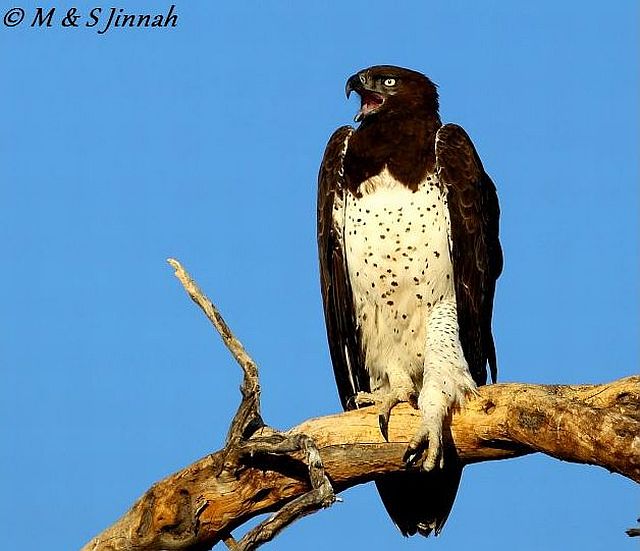 © Sharifa & Duke
© Sharifa & Duke
Links:
Species text in The Atlas of Southern African Birds: http://sabap2.adu.org.za/docs/sabap1/140.pdf
Sabap2: http://sabap2.adu.org.za/spp_summary.ph ... §ion=3
Global Raptor Information Network
Newman's birds of Southern Africa
Oiseaux net


 © Bushcraft
© BushcraftMatrial Eagle with full crop feeding on a Water Monitor, Kruger National Park, S39
Most raptors, including eagles, have a crop which is an out pouching of the esophagus, where they can store food when the stomach is full, or hold back indigestible stuff, such as feathers, fur, scales. This is than mixed with mucus and regurgitated.
 © Dewi
© DewiJuvenile, Kgalagadi Transfrontier Park
 © The Cow
© The CowJuvenile
 © ExFmem
© ExFmemJuvenile
 © Sprocky
© Sprocky © Goldenboy
© GoldenboyMartial Eagle eating a Vervet Monkey, Kruger National Park, Phabeni Road
 © Toko
© TokoNest in the Kgalagadi Transfrontier Park
 © Sharifa & Duke
© Sharifa & DukeLinks:
Species text in The Atlas of Southern African Birds: http://sabap2.adu.org.za/docs/sabap1/140.pdf
Sabap2: http://sabap2.adu.org.za/spp_summary.ph ... §ion=3
Global Raptor Information Network
Newman's birds of Southern Africa
Oiseaux net
Kgalagadi: Dec 2015
KNP Maroela, Shingwedzi & Pretoriuskop: March 2016
KNP Maroela, Shingwedzi & Pretoriuskop: March 2016
- Bushveld Jock
- Posts: 2001
- Joined: Sat Jun 02, 2012 3:52 pm
- Contact:
Long-crested Eagle
139. Long-crested Eagle Lophaetus occipitalis (Langkuifarend)
Accipitriformes. Family: Accipitridae
Description
Size: 52-58 cm. A small compact eagle.
Dark brown or black, white patches at the joint of the wing both above and below, white under-wing coverts spotted with black, a white base to the tail. Tail barred in flight. Has large yellow eyes and a narrow stove-pipe legs. Golden to reddish brown eyes, the cere and feet yellow.
Immatures can be distinguished from the adult by the whiter tips of the neck feathers, the less prominent crest, and a generally more mottled appearance. The eyes are dark olive-brown, the feet and cere pale ochre-yellow.
Distribution
Across sub-Saharan Africa; in southern Africa, it is locally common in Zimbabwe, central and southern Mozambique, eastern South Africa (Eastern Mpumalanga, Natal down to Eastern Cape), northern Botswana and the Caprivi Strip in Namibia.
Habitat: Woodland plantation and forest edges, specially near water.
Diet
Small mammals, reptiles, frogs, invertebrates and occasionally birds. It mainly eats rodents, doing most of its hunting in the early morning and late afternoon over a fairly small area. It usually hunts from a perch from which it searches for prey; once it spots something it glides to the ground and attempts to catch the animal.
Breeding
Monogamous, territorial solitary nester. The nest is built by both sexes, consisting of a stick platform with a central cup, lined with green leaves. It is typically placed against the trunk of a tree in the mid-canopy. Egg-laying season is year-round, peaking from July-November. It lays 1-2 eggs, which are mainly incubated by the female for about 42 days, while the male provides her with food at the nest. The chicks hatch asynchronously, sometimes up to 15 days apart, and are mainly fed by the male at first. They fledge at about 53 days old, remaining dependent on their parents for roughly another 2-3 months.
Call
Loud kee-ee keee-ay in aerial display. Listen to Bird Call.
Status
Fairly common resident; largely sedentary.
Accipitriformes. Family: Accipitridae
Description
Size: 52-58 cm. A small compact eagle.
Dark brown or black, white patches at the joint of the wing both above and below, white under-wing coverts spotted with black, a white base to the tail. Tail barred in flight. Has large yellow eyes and a narrow stove-pipe legs. Golden to reddish brown eyes, the cere and feet yellow.
Immatures can be distinguished from the adult by the whiter tips of the neck feathers, the less prominent crest, and a generally more mottled appearance. The eyes are dark olive-brown, the feet and cere pale ochre-yellow.
Distribution
Across sub-Saharan Africa; in southern Africa, it is locally common in Zimbabwe, central and southern Mozambique, eastern South Africa (Eastern Mpumalanga, Natal down to Eastern Cape), northern Botswana and the Caprivi Strip in Namibia.
Habitat: Woodland plantation and forest edges, specially near water.
Diet
Small mammals, reptiles, frogs, invertebrates and occasionally birds. It mainly eats rodents, doing most of its hunting in the early morning and late afternoon over a fairly small area. It usually hunts from a perch from which it searches for prey; once it spots something it glides to the ground and attempts to catch the animal.
Breeding
Monogamous, territorial solitary nester. The nest is built by both sexes, consisting of a stick platform with a central cup, lined with green leaves. It is typically placed against the trunk of a tree in the mid-canopy. Egg-laying season is year-round, peaking from July-November. It lays 1-2 eggs, which are mainly incubated by the female for about 42 days, while the male provides her with food at the nest. The chicks hatch asynchronously, sometimes up to 15 days apart, and are mainly fed by the male at first. They fledge at about 53 days old, remaining dependent on their parents for roughly another 2-3 months.
Call
Loud kee-ee keee-ay in aerial display. Listen to Bird Call.
Status
Fairly common resident; largely sedentary.
Kgalagadi: Dec 2015
KNP Maroela, Shingwedzi & Pretoriuskop: March 2016
KNP Maroela, Shingwedzi & Pretoriuskop: March 2016
- Bushveld Jock
- Posts: 2001
- Joined: Sat Jun 02, 2012 3:52 pm
- Contact:
Long-crested Eagle Photos
139. Long-crested Eagle Lophaetus occipitalis

 © Dewi
© Dewi
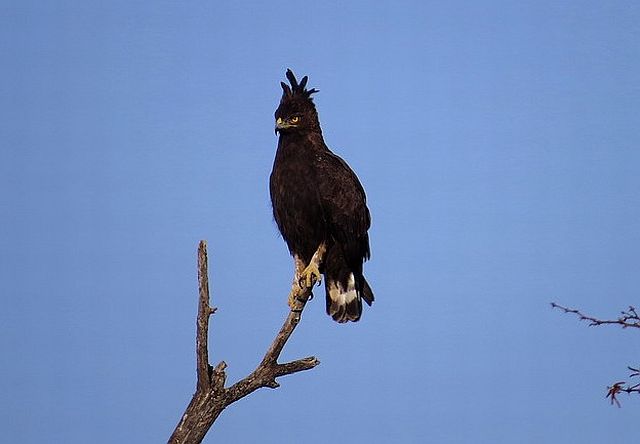 © The Cow
© The Cow
 © Amoli
© Amoli
Links:
Species text Sabap1: http://sabap2.adu.org.za/docs/sabap1/139.pdf
Sabap2: http://sabap2.adu.org.za/spp_summary.ph ... §ion=3
Sasol Birds of Prey of Africa
Global Raptor Information Network: http://www.globalraptors.org/grin/Speci ... pecID=8292
Newman's birds of Southern Africa
David Allan. A Photographic Guide to Birds of Prey of Southern, Central and East Africa
Oiseaux net: http://www.oiseaux-birds.com/card-long- ... eagle.html

 © Dewi
© Dewi © The Cow
© The Cow © Amoli
© AmoliLinks:
Species text Sabap1: http://sabap2.adu.org.za/docs/sabap1/139.pdf
Sabap2: http://sabap2.adu.org.za/spp_summary.ph ... §ion=3
Sasol Birds of Prey of Africa
Global Raptor Information Network: http://www.globalraptors.org/grin/Speci ... pecID=8292
Newman's birds of Southern Africa
David Allan. A Photographic Guide to Birds of Prey of Southern, Central and East Africa
Oiseaux net: http://www.oiseaux-birds.com/card-long- ... eagle.html
Kgalagadi: Dec 2015
KNP Maroela, Shingwedzi & Pretoriuskop: March 2016
KNP Maroela, Shingwedzi & Pretoriuskop: March 2016
- Sprocky
- Posts: 7110
- Joined: Sat May 19, 2012 12:29 pm
- Country: South Africa
- Location: Grietjie Private Reserve
- Contact:
Lesser Spotted Eagle
134. Lesser Spotted Eagle Clanga pomarina (Gevlekte Arend)
Order: Accipitriformes. Family: Accipitridae
Description
A medium sized, dark raptor. 55-65 cm in length and has a wingspan of 145-170 cm. Appears slender at perch; short, rounded tail; thin, fully-feathered legs; yellowish eyes. The head (without crest) and bill are small for an eagle. Sexes alike, female larger than male.
Adult: Overall plumage dark brown with paler head. The beak has round nostrils. The upperwing coverts are pale brown and have sometimes a small white primary patch, and even adults retain a clear-marked white V on the rump. Underwing coverts are normally paler than the flight feathers. The tail is rounded and in flight. When perched, best identified by ‘stove-pipe’ lower leggings and yellowish eyes.
Juvenile: Wing coverts usually darker than adult bird, with two rows of white tips to the upperwing coverts. Trailing edge of both tail and wings also tipped with white. A pale rufous area on the nape. Brown eyes.
Similar species: Similar to larger Steppe Eagle and smaller Wahlberg’s Eagle. When perched it is essentially a bulky version of Wahlberg’s Eagle in appearance, with a pale eye (not brown) and, in juveniles, white in the tail and wings. The thin leggings and the downward-bent primaries in flight distinguish this from other Aquila species. The yellow gape reaches below the eye (not beyond). Tawny Eagle and Steppe Eagle show barring in the primaries and tail, whick lacks the Lesser Spotted Eagle.
Taxonomy
The spotted eagles where formerly placed in the gunus Aquila, but form a clade sister to Lophaetus and to Ictinaetus. Wells & Inskipp (2012) treated them as a genus apart for which Clanga has priority (Gregory & Dickinson, 2012).
Distribution
It breeds in eastern Europe, heading south in the non-breeding season to Africa, from Egypt to South Africa. In southern Africa, it is locally common in patches of Mozambique, Zimbabwe, northern Botswana, north-eastern Namibia (including the Caprivi Strip) and north-eastern South Africa.
This Palearctic migrant from eastern Europe and Russia occurs in southern Africa from late October (mostly late November) to March. It is perhaps most frequently recorded in the Kruger National Park and the Moremi Game Reserve and Chobe National Park of northern Botswana, where it consorts with migrant Steppe Eagles.

Habitat
It generally prefers savanna and open woodland, generally avoiding mountainous and densely wooded areas. In southern Africa, mainly where annual rainfall exceeds 600 mm.
Movements and migrations
Palearctic breeding migrant, arriving in southern Africa in October; most birds depart in March.
Diet
Termites (flocks with Steppe Eagle at alate emergences); also nestlings, rodents and frogs.
Breeding
Extralimital. Breeding populations of the Lesser Spotted Eagle in central Europe commence egg laying in late April and early May. The birds build a large platform of twigs, usually high up in a tree, but on rare occasions on the ground, with a central nest cup, around 30 centimetres wide, lined with green twigs and sometimes with grass. A clutch of two eggs is normally laid, which are incubated for 36 to 41 days. During the following eight-week fledging period, the older chick frequently kills its younger sibling.
Call
Silent on non-breeding grounds.
Listen to Bird Call: http://www.xeno-canto.org/species/Clanga-pomarina
Status
Generally an uncommon and localized non-breeding Palaearctic migrant; gregarious. Present Oct-Mar.
Order: Accipitriformes. Family: Accipitridae
Description
A medium sized, dark raptor. 55-65 cm in length and has a wingspan of 145-170 cm. Appears slender at perch; short, rounded tail; thin, fully-feathered legs; yellowish eyes. The head (without crest) and bill are small for an eagle. Sexes alike, female larger than male.
Adult: Overall plumage dark brown with paler head. The beak has round nostrils. The upperwing coverts are pale brown and have sometimes a small white primary patch, and even adults retain a clear-marked white V on the rump. Underwing coverts are normally paler than the flight feathers. The tail is rounded and in flight. When perched, best identified by ‘stove-pipe’ lower leggings and yellowish eyes.
Juvenile: Wing coverts usually darker than adult bird, with two rows of white tips to the upperwing coverts. Trailing edge of both tail and wings also tipped with white. A pale rufous area on the nape. Brown eyes.
Similar species: Similar to larger Steppe Eagle and smaller Wahlberg’s Eagle. When perched it is essentially a bulky version of Wahlberg’s Eagle in appearance, with a pale eye (not brown) and, in juveniles, white in the tail and wings. The thin leggings and the downward-bent primaries in flight distinguish this from other Aquila species. The yellow gape reaches below the eye (not beyond). Tawny Eagle and Steppe Eagle show barring in the primaries and tail, whick lacks the Lesser Spotted Eagle.
Taxonomy
The spotted eagles where formerly placed in the gunus Aquila, but form a clade sister to Lophaetus and to Ictinaetus. Wells & Inskipp (2012) treated them as a genus apart for which Clanga has priority (Gregory & Dickinson, 2012).
Distribution
It breeds in eastern Europe, heading south in the non-breeding season to Africa, from Egypt to South Africa. In southern Africa, it is locally common in patches of Mozambique, Zimbabwe, northern Botswana, north-eastern Namibia (including the Caprivi Strip) and north-eastern South Africa.
This Palearctic migrant from eastern Europe and Russia occurs in southern Africa from late October (mostly late November) to March. It is perhaps most frequently recorded in the Kruger National Park and the Moremi Game Reserve and Chobe National Park of northern Botswana, where it consorts with migrant Steppe Eagles.

Habitat
It generally prefers savanna and open woodland, generally avoiding mountainous and densely wooded areas. In southern Africa, mainly where annual rainfall exceeds 600 mm.
Movements and migrations
Palearctic breeding migrant, arriving in southern Africa in October; most birds depart in March.
Diet
Termites (flocks with Steppe Eagle at alate emergences); also nestlings, rodents and frogs.
Breeding
Extralimital. Breeding populations of the Lesser Spotted Eagle in central Europe commence egg laying in late April and early May. The birds build a large platform of twigs, usually high up in a tree, but on rare occasions on the ground, with a central nest cup, around 30 centimetres wide, lined with green twigs and sometimes with grass. A clutch of two eggs is normally laid, which are incubated for 36 to 41 days. During the following eight-week fledging period, the older chick frequently kills its younger sibling.
Call
Silent on non-breeding grounds.
Listen to Bird Call: http://www.xeno-canto.org/species/Clanga-pomarina
Status
Generally an uncommon and localized non-breeding Palaearctic migrant; gregarious. Present Oct-Mar.
Sometimes it’s not until you don’t see what you want to see, that you truly open your eyes.
- Sprocky
- Posts: 7110
- Joined: Sat May 19, 2012 12:29 pm
- Country: South Africa
- Location: Grietjie Private Reserve
- Contact:
Lesser Spotted Eagle Photos
134. Lesser Spotted Eagle Clanga pomarina
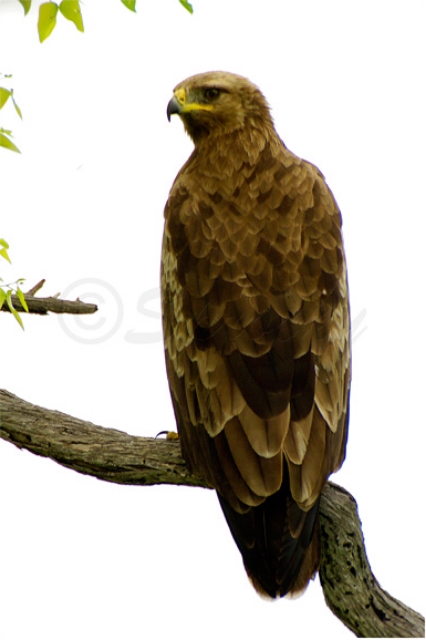 © Sprocky
© Sprocky
Kruger National Park © Lisbeth
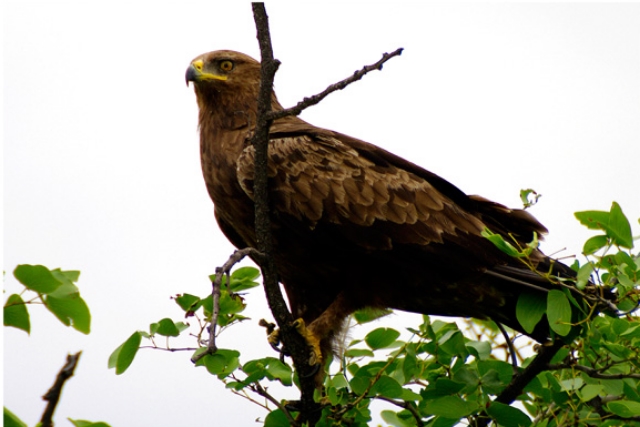 © Sprocky
© Sprocky
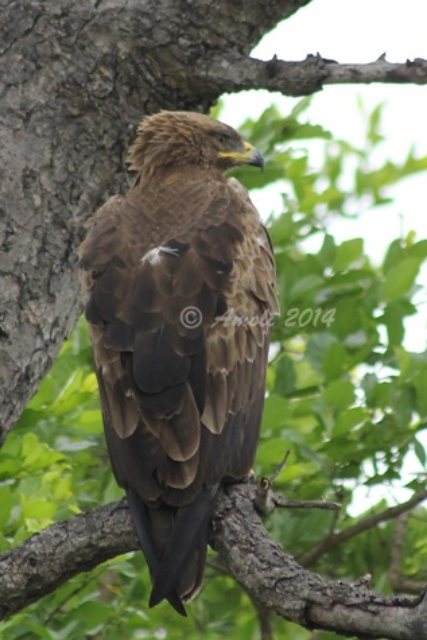 © Amoli
© Amoli
Kruger National Park
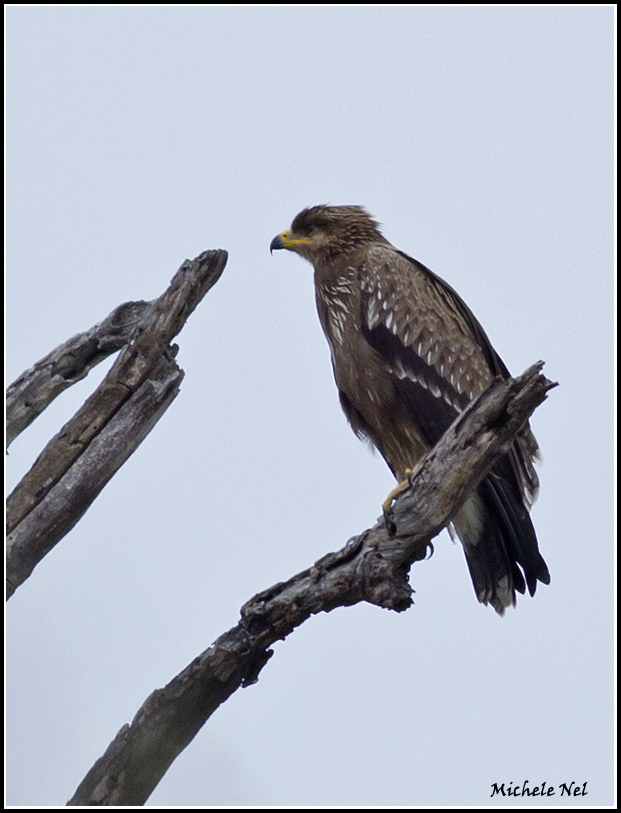 © Michele Nel
© Michele Nel
Juvenile Lesser Spotted Eagle
Links:
Species text Sabap1
Sabap2
Sasol Birds of Prey of Africa
William S. Clark. A field guide to the raptors of Europe, The MIddle East and North Africa
David Allan. A Photographic Guide to Birds of Prey of Southern, Central and East Africa
 © Sprocky
© SprockyKruger National Park © Lisbeth
 © Sprocky
© Sprocky © Amoli
© AmoliKruger National Park
 © Michele Nel
© Michele NelJuvenile Lesser Spotted Eagle
Links:
Species text Sabap1
Sabap2
Sasol Birds of Prey of Africa
William S. Clark. A field guide to the raptors of Europe, The MIddle East and North Africa
David Allan. A Photographic Guide to Birds of Prey of Southern, Central and East Africa
Sometimes it’s not until you don’t see what you want to see, that you truly open your eyes.
Wahlberg’s Eagle
135. Wahlberg’s Eagle Hieraaetus wahlbergi (Bruinarend)
ORDER ACCIPITRIFORMES. Family: Accipitridae
Description
55-60 cm. Very variable in colour, from buff to dark brown, occasionally all-white or having mixed light and dark plumage. The flight shape is diagnostic, with long, straight-edged wings and a long narrow, square-ended tail. At rest it shows a small, pointed crest. Yellow bill with black tip.
Female larger and usually darker than male. Juvenile resembles adult.
Adult pale morph: Head and neck mainly creamy white, with blackish streaks on crown and around eye. Remainder of upper parts dark grey-brown, feathers broadly edged whitish. Underparts, incl underwing coverts, creamy white, variably spotted or streaked dark brown, contrasting with darker flight feathers and tail.
Adult dark morph: Head dark brown, crown slightly paler rufous; nuchal crest (sometimes held flattened) distinctive. Body, wings and tail dark brown, upper wing coverts narrowly edged paler brown, contrasting slightly with blackish-brown flight feathers. Undersides of flight feathers slightly paler grey-brown, with fine darker brown barring. Undertail grey-brown, with narrow blackish bars. Bill blackish; cere and large, fleshy gape yellow. Eyes brown. Shaggy leggings brown; toes yellow.
Adult intermediate morph: As dark morph, but head often slightly darker than body. Body and wing coverts mid-brown or buffy, contrasting with dark brown flight feathers and tail. Undersides of secondaries grey-brown, finely barred blackish brown, with broad blackish tips. Primaries even paler silvery grey, with broad blackish tips. Some with off-white fringes to most body feathers, or with whitish breast, belly and vent.
Distinctive features of Wahlberg's Eagle include: round nostrils which separates it from Tawny Eagle and Steppe Eagles, although the two Spotted Eagles also have round nostrils; some form of a crest is usually visible; the gape only extends at maximum to the middle of the eye, whereas in Lesser Spotted Eagle, it extends to the back of the eye. Pale-form birds could be confused with pale-form Booted Eagle (https://africawild-forum.com/viewtopic. ... 030#p45030) but differ in flight shape and by the long pencil-thin tail, as well as in having more white on the head.
Similar species: Lesser Spotted Eagle has much broader wings with white bases to primaries, shorter, rounded tail and narrow 'stove-pipe' (not shaggy) leggings; eyes yellow (not brown). Booted Eagle has paler, plain (not barred) undertail, contrasting pale median upper wing coverts and white 'landing lights' at base of leading edge of upper wing. Brown Snake- Eagle has paler, plain (not barred) flight feathers and more strongly barred tail; head large, eyes yellow (not brown), tarsi bare (not feathered). Black Kite smaller-headed and longer-bodied, with forked (not square) tail.
Taxonomy
The Wahlberg‘s Eagle has been moved from genus Aquila to Hieraaetus (Helbig 2005, Lerner & Mindell 2005).
Distribution
Occupies much of sub-Saharan Africa, excluding the lowland forest of the DRC and adjacent West African countries. In southern Africa, it is common in Zimbabwe, Mozambique, north-eastern South Africa, northern and south-eastern Botswana and northern and central Namibia (including the Caprivi Strip).
Habitat
Woodland and savannah.
Movements and migrations
Intra-African breeding migrant, arriving in southern Africa in the period from August-September, and departing in March and April. Its presence in the region corresponds with the annual peak in rainfall, which allows the adults to find food their chicks more easily. Average arrival date at Skukza, Kruger Park is July, 31.
Diet
Wide variety of animals, especially birds, mammals and reptiles.
Breeding
Monogamous, territorial solitary nester, performing incredible aerial courtship displays in which both sexes undulate their flight. The nest is built by both sexes, consisting of a small, strongly-built platform of thin sticks thickly lined with green leaves. It is typically placed in the fork of the canopy of a tall tree, especially a Jackal-berry or Knob-thorn overlooking a dry watercourse. Egg-laying season is from August-January, peaking from September-October. It almost invariably lays a single egg (rarely two), which is mainly incubated by the female for about 44-46 days. The chick is fed by the female with food provided by the male, leaving the nest at about 70-75 days old.
Call
A drawn-out whistle while soaring, and yelping kop-yop-yip-yip-yip when perched. Fast quee-quee-quee and mounful kleeeee-eee.
Listen to Bird Call: http://www.xeno-canto.org/species/Hieraaetus-wahlbergi
Status
Common summer visitor to the North and East from Central Africa.
ORDER ACCIPITRIFORMES. Family: Accipitridae
Description
55-60 cm. Very variable in colour, from buff to dark brown, occasionally all-white or having mixed light and dark plumage. The flight shape is diagnostic, with long, straight-edged wings and a long narrow, square-ended tail. At rest it shows a small, pointed crest. Yellow bill with black tip.
Female larger and usually darker than male. Juvenile resembles adult.
Adult pale morph: Head and neck mainly creamy white, with blackish streaks on crown and around eye. Remainder of upper parts dark grey-brown, feathers broadly edged whitish. Underparts, incl underwing coverts, creamy white, variably spotted or streaked dark brown, contrasting with darker flight feathers and tail.
Adult dark morph: Head dark brown, crown slightly paler rufous; nuchal crest (sometimes held flattened) distinctive. Body, wings and tail dark brown, upper wing coverts narrowly edged paler brown, contrasting slightly with blackish-brown flight feathers. Undersides of flight feathers slightly paler grey-brown, with fine darker brown barring. Undertail grey-brown, with narrow blackish bars. Bill blackish; cere and large, fleshy gape yellow. Eyes brown. Shaggy leggings brown; toes yellow.
Adult intermediate morph: As dark morph, but head often slightly darker than body. Body and wing coverts mid-brown or buffy, contrasting with dark brown flight feathers and tail. Undersides of secondaries grey-brown, finely barred blackish brown, with broad blackish tips. Primaries even paler silvery grey, with broad blackish tips. Some with off-white fringes to most body feathers, or with whitish breast, belly and vent.
Distinctive features of Wahlberg's Eagle include: round nostrils which separates it from Tawny Eagle and Steppe Eagles, although the two Spotted Eagles also have round nostrils; some form of a crest is usually visible; the gape only extends at maximum to the middle of the eye, whereas in Lesser Spotted Eagle, it extends to the back of the eye. Pale-form birds could be confused with pale-form Booted Eagle (https://africawild-forum.com/viewtopic. ... 030#p45030) but differ in flight shape and by the long pencil-thin tail, as well as in having more white on the head.
Similar species: Lesser Spotted Eagle has much broader wings with white bases to primaries, shorter, rounded tail and narrow 'stove-pipe' (not shaggy) leggings; eyes yellow (not brown). Booted Eagle has paler, plain (not barred) undertail, contrasting pale median upper wing coverts and white 'landing lights' at base of leading edge of upper wing. Brown Snake- Eagle has paler, plain (not barred) flight feathers and more strongly barred tail; head large, eyes yellow (not brown), tarsi bare (not feathered). Black Kite smaller-headed and longer-bodied, with forked (not square) tail.
Taxonomy
The Wahlberg‘s Eagle has been moved from genus Aquila to Hieraaetus (Helbig 2005, Lerner & Mindell 2005).
Distribution
Occupies much of sub-Saharan Africa, excluding the lowland forest of the DRC and adjacent West African countries. In southern Africa, it is common in Zimbabwe, Mozambique, north-eastern South Africa, northern and south-eastern Botswana and northern and central Namibia (including the Caprivi Strip).
Habitat
Woodland and savannah.
Movements and migrations
Intra-African breeding migrant, arriving in southern Africa in the period from August-September, and departing in March and April. Its presence in the region corresponds with the annual peak in rainfall, which allows the adults to find food their chicks more easily. Average arrival date at Skukza, Kruger Park is July, 31.
Diet
Wide variety of animals, especially birds, mammals and reptiles.
Breeding
Monogamous, territorial solitary nester, performing incredible aerial courtship displays in which both sexes undulate their flight. The nest is built by both sexes, consisting of a small, strongly-built platform of thin sticks thickly lined with green leaves. It is typically placed in the fork of the canopy of a tall tree, especially a Jackal-berry or Knob-thorn overlooking a dry watercourse. Egg-laying season is from August-January, peaking from September-October. It almost invariably lays a single egg (rarely two), which is mainly incubated by the female for about 44-46 days. The chick is fed by the female with food provided by the male, leaving the nest at about 70-75 days old.
Call
A drawn-out whistle while soaring, and yelping kop-yop-yip-yip-yip when perched. Fast quee-quee-quee and mounful kleeeee-eee.
Listen to Bird Call: http://www.xeno-canto.org/species/Hieraaetus-wahlbergi
Status
Common summer visitor to the North and East from Central Africa.
PuMbAa
Please visit our website: www.photomaniacs.de
Please visit our website: www.photomaniacs.de
Wahlberg’s Eagle Photos
135. Wahlberg’s Eagle Hieraaetus wahlbergi
 © Pumbaa
© Pumbaa
 © Pumbaa
© Pumbaa
Kruger National Park
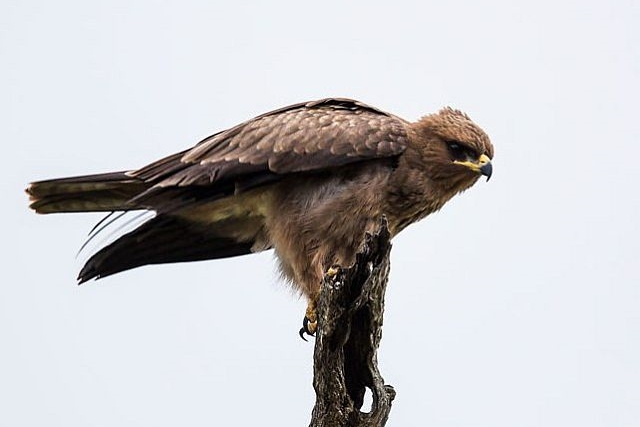 © Pumbaa
© Pumbaa
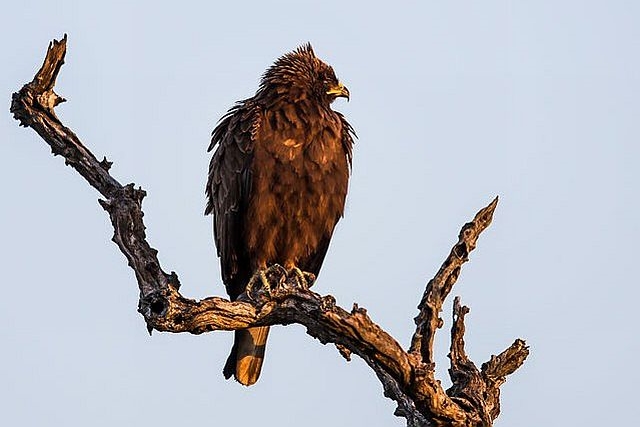 © Pumbaa
© Pumbaa
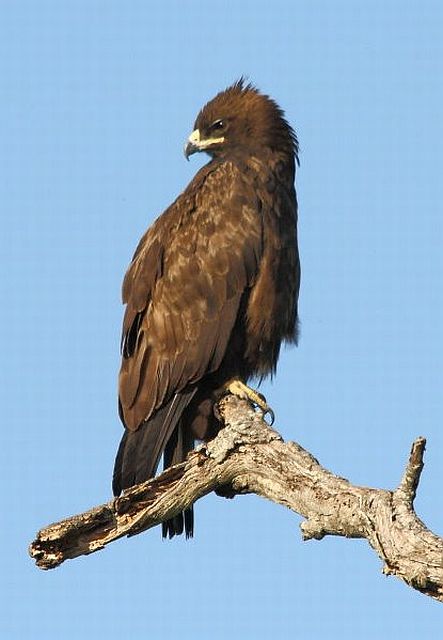 © Flutterby
© Flutterby
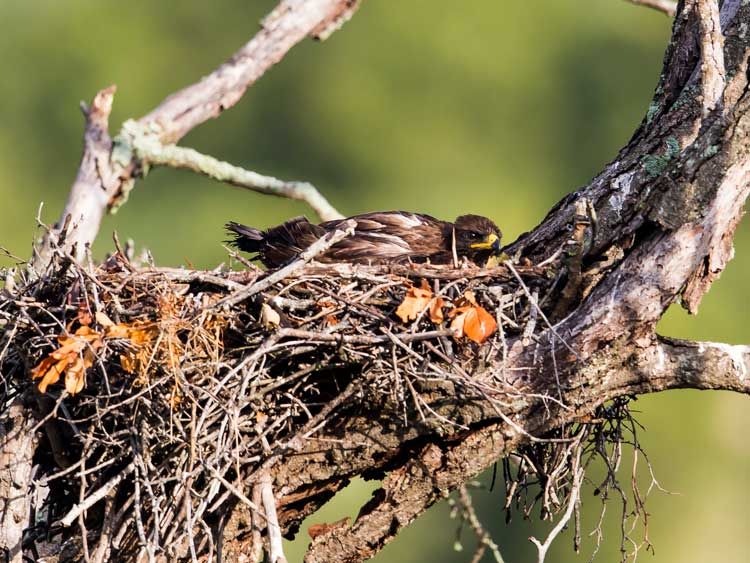 © Pumbaa
© Pumbaa
Kruger National Park, Feb 2020
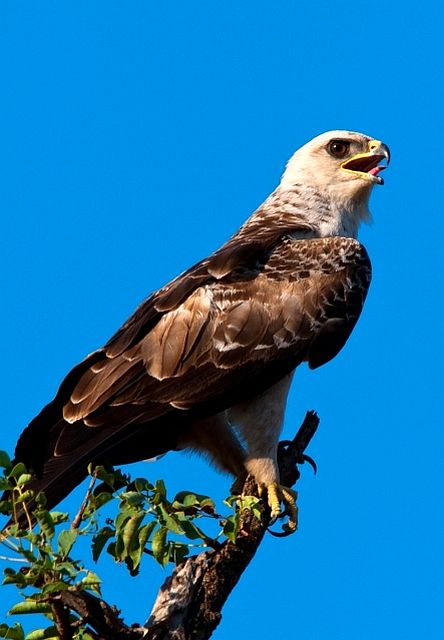 © BluTuna
© BluTuna
 © Guinea Pig
© Guinea Pig
Kruger National Park
 © nan
© nan
Kruger National Park
Links:
http://sabap2.adu.org.za/docs/sabap1/135.pdf
http://sabap2.adu.org.za/spp_summary.ph ... §ion=3
http://www.globalraptors.org/grin/Speci ... pecID=8171
 © Pumbaa
© Pumbaa © Pumbaa
© PumbaaKruger National Park
 © Pumbaa
© Pumbaa © Pumbaa
© Pumbaa © Flutterby
© Flutterby © Pumbaa
© PumbaaKruger National Park, Feb 2020
 © BluTuna
© BluTuna © Guinea Pig
© Guinea PigKruger National Park
 © nan
© nanKruger National Park
Links:
http://sabap2.adu.org.za/docs/sabap1/135.pdf
http://sabap2.adu.org.za/spp_summary.ph ... §ion=3
http://www.globalraptors.org/grin/Speci ... pecID=8171
PuMbAa
Please visit our website: www.photomaniacs.de
Please visit our website: www.photomaniacs.de


